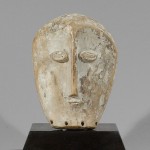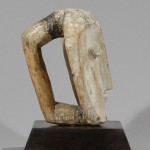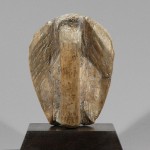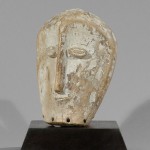HCK 1015-02
Lega Dance Mask with Handle, Zaïre (Democratic Republic Congo)
H: 17,5 cm (6,9″), W: 13,5 cm (5,3″)
Wood, with a thick layer of kaolin
This is a very rare and unusual Lega dance mask (idimu) with a handle on the back of the mask. The friendly smiling expression indicates that it is used in a happy ceremonial event.
Most of Lega masks are sculptures of a human face that are rarely worn over the face and never for purposes of true transformation. The Lega masks can be assigned different uses and meanings depending on the context of the performance. In Bwami ceremonies, masks are attached to different parts of the body, fixed to hat, piled in stacks, hung on fences, held in the hand, dragged on the ground, and occasionally worn on the forehead with the beard draping over the face of the wearer or arranged on a miniature palisade. Participants in most rites display their masks as a group in conjunction with particular dance movements and aphorisms, which vary depending on the context in which they are used. Lega masks differ from those used in many other African masquerades in that while women do not own them, both men and women handle and present them in very similar performances. Masks are among the initiation objects displayed on the grave before being passed to new owners. They are usually passed from an uncle to a nephew. Idumu masks are unusual because they belong to a group of people rather than one individual. During a major performance an idumu mask is hung on a fence among other smaller lukwakongo masks (these are owned by specific persons).
All Lega art is used within the context of the Bwami society. Bwami is responsible for teaching morality through community performances, dances and objects.
Originally Lega art was primarily wooden, but little by little, ivory came into use. Later many works were made of this material that allowed more complex and refined forms and a beautiful patina. The highest ranking members of the Bwami association commission, own, use and interpret all Lega sculpture. The genius of the Lega artist lies in his ability to produce a work that fulfills the requirements of the Bwami patron, fits perfectly within the canon, and yet is artistically unique. Various categories of objects are used in connection with the association’s activities, including anthropomorphic and zoomorphic figurines, masks, hats, and others. Each anthropomorphic figurine symbolically represents a named personage with particular moral qualities or defects that are expressed through dance and sung aphorisms in initiations to the highest grades of the association. Although quite primitive and coarse in style and execution, very expressive Lega sculpture convey the strong sense of balance, form and serenity. The Lega judge the quality of their sculpture on the basis of its effectiveness.
Age: First half of the 20th century (before 1950).
Provenance: Originates from a Dutch Collection. Then sold to a private Belgian collection.
Literature: Felix, Marc L., Maniema, München
Request price for Lega Mask




